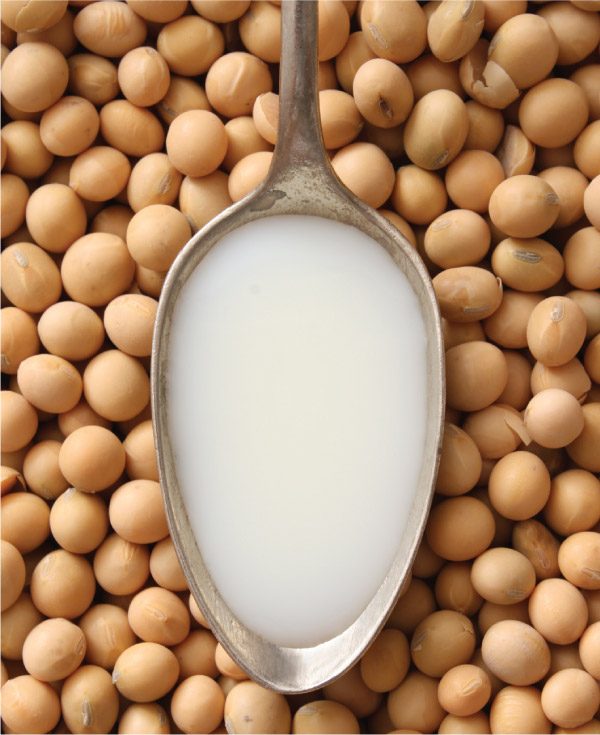SOYFOODS +INFANTS, CHILDREN& ADOLESCENTS
Eating habits early in life may impact adult chronic diseases.This fact sheet will explore soyfoods’ beneficial role in the diets of infants, children and adolescents.
Introduction
Establishing healthful eating habits early in life is important for at least two reasons. The first being childhood eating habits track into adulthood, and changing adult dietary behavior is difficult.1-6 In fact, recent research shows that dietary habits established during infancy track into mid-childhood.7 The second reason is that evidence suggests healthful behaviors during childhood and adolescence can affect the risk of developing certain chronic diseases later in life.8-11For example, early lifestyle factors are thought to affect the likelihood of developing breast cancer.12Additionally, childhood obesity is associated with increased mortality from cardiovascular disease in adulthood, independent of adult weight.13This observation is especially important given that 36 percent of U.S. children are overweight.14

Diseases once seen primarily in adults, such as hypertension15 and Type 2 diabetes mellitus,16 are increasingly common in childhood.
Evidence indicates it isn’t just that chronic diseases begin early in life, but that programming during fetal life and infancy permanently affects the risk of developing non-communicable diseases in adult life.
Programming refers to permanent changes in the body’s structure, physiology and metabolism, which influences health throughout life. Programming is not just limited to the in-utero environment but extends into childhood, where different organs and systems continue to adapt to various cues.
Another acknowledgement is that the beginning stages of chronic diseases such as coronary heart disease are already apparent in adolescents.17,18 Importantly, there is an emerging epidemic of non-alcoholic fatty liver disease (NAFLD) estimated to affect millions of obese children19,20 and one out of every four adults globally.21 Autopsy findings show that 9.6% of the U.S. population, age 2-19 years and 38% of the obese individuals within this age range have NAFLD.22 NAFLD can progress to non-alcoholic steatohepatitis, which is characterized by oxidative stress, inflammation, apopotosis and fibrogenesis.23 Some animal24-27 and epidemiologic28 data suggests soy may help to prevent the development of NAFLD.
Given the importance of early-life dietary behavior, it is useful to understand how the nutritional attributes of soyfoods may impact the health of young people from infancy through teenage years.

Soy Infant Formula
Although breast milk is the ideal food for infants, about one-third of U.S. women are unable to breastfeed or choose not to do so.29 Of those who choose breastfeeding, most switch to formula feeding at some point in the infant's first year.30Commercially-prepared, fortified infant formulas are appropriate to supplement or replace human milk during the first year of life. Soy infant formula (SIF) is fortified with iodine, iron, methionine, carnitine and taurine, and contains 20 percent more calcium and phosphorous than cow’s milk formulas.
There are various estimates for the prevalence of SIF. A recent survey of a nationally representative sample of 1,864 infants, 0 to 12 months old, from the National Health and Nutrition Examination Survey, 2003-2010, found that among the 81 percent of infants who were fed formula or regular milk, 12 percent consumed SIF.31 The percentage of infants consuming SIF was significantly higher(P < 0.05) among those from higher income groups compared with the lowest income group.
An allergy to milk protein is among the most common reasons for placing an infant on SIF. Although there is evidence that SIF is hypoallergenic and relative to cow’s milk formula,32 an estimated 10-14 percent of infants who are allergic to cow’s milk formula are also allergic to SIF. As a result, the American Academy of Pediatrics (AAP) suggests that infants with documented cow’s milk protein allergy (CMA) should be switched directly to a hydrolyzed-protein formula.33 It should be noted that soybean-specific immunoglobulin E (IgE) titers are not an effective predictor of a positive response to the food challenge test.34

In contrast to the AAP, an Australian panel of experts concluded that SIF is an appropriate alternative for infants over six months old who demonstrate immediate food allergy to cow’s milk and delayed reaction in the form of atopic eczema and other gastrointestinal syndromes.35 The French Society of Pediatrics holds a similar position but with the caveat that tolerance to soy protein should first be established by clinical challenge.36 Importantly, U.K. research found that of the 60% of all infants with CMA initially fed SIF, only 9% remained symptomatic.37 In contrast, of the 18% of patients consuming extensively hydrolyzed formula, 29% remained symptomatic. The results from a small retrospective study from Portugal, which evaluated children with persistent CMA, also suggest that SIF formula may have advantages over hydrolyzed formulas.38
A systematic review and meta-analysis, which included 40 studies that evaluated the prevalence of IgE-mediated soy allergies in infants and children, concluded that recommendations to postpone the introduction of SIF in infants with IgE-CMA during the first six months of life were based on the concern for an increased risk of allergy to soy and are not warranted.39 More recently, Vandenplas40 concluded that cow-milk based extensive hydrolysates are the first option for the treatment of CMA for the majority of patients, while amino acid formulas are reserved for the most severe cases, whereas rice hydrolysates and SIF are second choice options.
Isoflavones in Diets of Infants Fed Soy Formula
An estimated 20 million people in the U.S. consumed SIF during infancy since it first became commercially available in the 1960s.41 Despite its long history of use, SIF has become controversial in recent years due to its naturally high isoflavone content.42,43 In the mid-1960s, several cases of goiter were identified in infants using SIF.44-46 Soon after, iodine was added to the formula: since fortification began, no thyroid problems attributed to SIF use have been identified in healthy infants, and research shows that infants fed SIF grow and develop normally.41,47-50 SIF may be contraindicated for infants with congenital hypothyroidism who require synthetic thyroid hormone,51 not because the formula contains isoflavones, but because of evidence suggesting soy protein is one of a number of factors that may interfere with the absorption of thyroid medication.52
In 2006, the National Toxicology Program (NTP) Center for the Evaluation of Risks to Human Reproduction evaluated the safety of SIF. Although their initial conclusions supported the safety of SIF, no final report was issued.53,54 In 2009, the NTP again took up this issue. The conclusion of the 14-member panel of independent scientists was that there was “minimal concern” (the five levels of concern are negligible concern, minimal concern, some concern, concern and serious concern) about the safety of SIF.55 In response to the NTP report, the AAP submitted a formal letter to the NTP, in which they stated their position that there is negligible concern about the safety of SIF. The current position of the AAP is that “... isolated soy protein-based formulas may be used to provide nutrition for normal growth and development ...”33

In 2014, the first published systematic review and meta-analysis to focus on the safety of SIF concluded that in normal full-term infants – Contributing to this controversy are the results of an epidemiologic study by Adgent et al.58 published in 2018 which suggest that SIF may exert modest estrogenic effects in infant girls but not boys. This study garnered considerable media attention. However, as described below, a subsequently published study not involving SIF should give considerable pause about drawing any long-term conclusions about the health effects of SIF based on studies in infants.59
The study Adgent et al.enrolled 410 infants born in Philadelphia-area hospitals between 2010 and 2014 that were exclusively fed SIF, cow-milk formula or breast milk throughout the study (birth to 28 or 36 weeks for boys and girls, respectively).58 Maternal demographics did not differ between cow-milk fed and SIF-fed infants but did differ markedly between formula fed and breastfed infants. Vaginal-cell maturation index (a marker of estrogen exposure) trended higher and uterine volume decreased more slowly in SIF-fed girls compared with cow-milk formula-fed girls; however, their trajectories of breast-bud diameter and hormone concentrations did not differ.The authors concluded that SIF “demonstrated tissue- and organ-level developmental trajectories consistent with response to exogenous estrogen exposure” but readily acknowledged that the long-term implications of these differences,if any, are unknown.
This study makes an important contribution to the literature.58 However, because it is an epidemiologic study rather than a randomized controlled trial, it is important to recognize its inherent limitations. Furthermore, the effects in girls contrast with results from the Beginnings study, which have shown SIF does not produce estrogenic effects in girls or boys in comparison to infants fed cow-milk formula or breast milk.60 Interestingly, at four months of age, the ovarian volume of the cow-milk formula-fed infants was statistically significantly larger than that of infants in the other two groups, which is suggestive of an estrogenic effect.61 However, by five years of age this difference in ovarian size was no longer evident.62 Thus, the impact of cow’s milk formula was transient.
The transient effect of cow-milk formula on ovarian volume is consistent with the results of a recent study Fleddermann et al.59 The Belgrade-Munich infant milk trial found there were nolong-term effects resulting from marked differences in growth patterns up to four months of age due to differences in formula feeding, on anthropometry at four years of age.59 This study was a randomized controlled trial in which healthy term infants received either a protein-reduced infant formula or a standard formula. Non-randomized breastfed infants were used as a reference group. The increase in weight and length z-scores between one and four months of age was higher for low-protein formula-fed infants than for the standard-formula-fed infants. However, after four months of age, a significantly lower increase in z-scores (for weight and length) was observed in the infants fed the low-protein formula compared with the infants fed the standard formula. Consequently, there were no differences at four years of age.
The transient effects in infants resulting from differences in dietary intake in the Beginnings study62 and The Belgrade-Munich infant milk study59 should give considerable pause about drawing conclusions about the long-term health implications of formula feeding based on differences observed in infants. Insights about infant feeding patterns may need to come from long-term prospective studies or carefully controlled retrospective studies.

Isoflavones in Diet of Children
Young Asians have consumed soyfoods for centuries without any apparent adverse effects. Nevertheless, there is interest in gaining a better understanding of the effects of isoflavones in children. Preliminary data indicates that children absorb isoflavones to a greater extent than adults do.63

| 1 | An Australian study found that isoflavones have no effect on high-density lipoprotein cholesterol (HDL-C) levels in teenage boys, which suggests isoflavones don’t exert estrogenic effects.64 HDL-C levels decrease in boys as they enter puberty, whereas no such decrease occurs in girls, a difference that may be due to the higher estrogen levels in females. It was hypothesized that isoflavone exposure would raise HDL-C. |
| 2 | A small Israeli 12-week cross-over study found isoflavone supplements (0, 16 and 48 mg/d) had no effect on blood reproductive hormone levels in young boys and girls. |
| 3 | A pilot U.S. study involving 17 girls found that the consumption of approximately one serving of soyfoods daily (average isoflavone intake, ~27 mg) had no effect on urinary sex steroid levels. |
The lack of apparent hormonal effects in these clinical trials involving children is consistent with research in adults, showing that isoflavone exposure from soyfoods or supplements has no effect on circulating testosterone in men67 or estrogen levels in men68 or women.69
There is increasing interest in understanding the impact of diet on pubertal development because pubertal characteristics are occurring at an earlier age in U.S. girls.70,71 Many factors likely contribute to this trend such as increasing adiposity. Epidemiologic studies have found that both total protein and animal protein intake is associated with earlier menarche and the development of early pubertal characteristics.72,73 Xenoestrogen exposure, which includes phytoestrogens such as isoflavones, has been proposed as another factor leading to earlier puberty onset. For this reason, there is interest in determining whether soy intake affects pubertal development.
Two small Korean epidemiologic studies found that urinary isoflavones in children with precocious puberty were higher than in children serving as controls.74,75 Age of menarche (AOM) has been declining (i.e. occurring at a young age) in Korea but an analysis found that in addition to diet and nutrition, maternal menarcheal age, body mass index and maternal age at birth were variables that appear to influence AOM in Korean girls.76 It is important to note the AOM is generally declining throughout the world including in countries where soyfoods are not consumed.
In contrast to the Korean studies,74,75 a prospective study involving 1,239 U.S. girls aged 6-8 who were followed for seven years found no relationship between pubertal development and urinary isoflavone excretion.77 In fact, another U.S. study found isoflavone exposure was associated with delayed breast development, although this study was small and utilized a cross-sectional design.78 Nevertheless, this finding agrees with the results of a German longitudinal study.79

However, epidemiologic studies conducted outside of Asia involving the general population are of questionable utility for understanding the health effects of soy consumption because isoflavone intake is so low (<2 mg/d).
Two U.S cross-sectional studies provide more meaningful insight into whether soy intake impacts pubertal development. One study involved Seventh-day Adventist (SDA) girls (N=327; age range 12 to 18; mean age, 15)80 and the other study involved SDA boys.81 Approximately 40 percent of SDAs are vegetarians so their soy consumption is much higher than the general U.S. population. The authors of these studies assumed that current soy intake reflected past intake, an assumption that is supported by the literature.82
The average number of servings of soyfoods among the adolescent girls was 12.9 per week and 21.1 percent of the girls consumed soyfoods ≥4x/week. The results showed that the consumption of total soyfoods and the intake of three specific soyfoods was not significantly associated with AOM or with the odds for early or late-AOM.
In the study involving boys, puberty onset as judged by first appearance of pubic hair in high-soy-consumers (>20 mg/d isoflavones) was found to be well within the normal range for U.S. children.
One adverse effect associated with earlier puberty in girls is an increased risk of developing breast cancer later in life. While the effect of soy on puberty has been studied to only a very limited extent, there is an impressive body of research, consisting of both epidemiologic83-86 and animal87-89 data, indicating that soy intake when young reduces breast cancer risk later in life.
This evidence is consistent with mounting data that early life events greatly impact breast cancer risk90 and cancer risk in general.91 The first 20 years of life appear to be particularly important.92

| SOYFOOD | SERVING SIZE | GRAMS OF SOY PROTEIN |
|---|---|---|
| Fortified Soymilk | 1 cup | 6-7 |
| Soy Cereal | 1 ¼ cup | 7 |
| Soy Yogurt, Vanilla | 1 cup | 6 |
| Soy Breakfast Patty | 2 patties | 11 |
| Soy Bar | 1 bar | 14 |
| Soy Chips | 1 bag | 7 |
| Soynut Butter | 2 tbsp | 7 |
| Soynuts, Roasted, Unsalted | ¼ cup | 11 |
| Tofu | ½ cup | 10 |
| Edamame | ½ cup | 11 |
| Soy Burger | 1 patty | 13-14 |
| Soy Pasta | ½ cup (cooked) | 13 |
| Soy Pudding | ½ cup | 6 |
Source: United States Department of Agriculture Nutrient Database.
Effects of Soy Protein on Cholesterol Levels in Children
As with adults, clinical research in children shows that soy protein favorably affects lipid levels.93-97 In the most recent study, when soy protein (average intake 0.5 g/kg body weight) was incorporated into the diets of children and adolescents (mean age 8.8 years; range 4-18 years) with familial and polygenic hypercholesterolemia, low-density lipoprotein cholesterol decreased by 6.4% beyond the 11% decrease that occurred in response to the adoption of a standard low-saturated fat diet during the three-month run-in period.97 Therefore, soy protein used in combination with other dietary therapies can help to reduce cholesterol levels to target goal.98 Soy protein may also serve as an adjunct to therapy in children taking medication for lowering cholesterol, thereby reducing the required medication dose, which may help to minimize or eliminate side effects.99
Soy Protein Quality
Soyfoods provide high-quality protein and are generally low in saturated fat.100 Soy protein can meet the protein needs of growing children. In 2000, the U.S. Department of Agriculture removed limits on the amount of soy protein that can be used in the National School Lunch Program (NSLP).101 To qualify as an alternate protein product in the NSLP requires that a protein have a protein digestibility corrected amino acid score of at least 80 percent of that of casein; soy protein easily meets this standard.102
Providing healthful sources of protein without excessive saturated fat content is important for children. Higher-protein diets are associated with greater satiety and weight loss.103 Evidence in young boys, although limited, shows that consumption of protein above the recommended dietary allowance enhances the favorable impact of physical activity on bone mineral density.104 Additionally, evidence indicates that the protein requirements of children may be 50 percent higher than the current recommended dietary allowance.105
Many protein-rich foods in children’s diets are high in saturated fat. Substituting soyfoods for more traditional sources of protein generally improves overall diet quality. Even substituting soy protein for part of the beef or pork protein in a recipe can lead to a decrease in the fat, saturated fat and calorie content for the total entree, as long as portion size stays the same.106,107 Similarly, combining cheese, eggs or meat with tofu leads to improved nutritional quality of entrees.108
In general, soyfoods help children meet the dietary guidelines. Short-term studies show that soyfoods support the normal growth and development of children109 and improve growth when substituted for legumes in the diets of malnourished preschoolers.110,111 Furthermore, according to a recent clinical trial involving Australian children 18 to 114 months old, soymilk may help to alleviate chronic functional constipation (CFC), which is defined as having one bowel motion every three to 15 days.112 CFC occurs commonly in children and among those children attending a consultation with a pediatrician, the prevalence may be as high as 36 percent. Collectively, the evidence shows soyfoods can play an important part in a healthful and varied diet.
Soy Protein Allergies
Essentially all food proteins have the potential to cause allergic reactions in some individuals. Although soy protein is one of the eight food proteins responsible for approximately 90 percent of all allergic reactions, these eight foods are not equally allergenic. The number of adults allergic to soy protein is quite small. According to the most recent survey conducted by the U.S. Food and Drug Administration, one out of every 1,000 American adults are allergic to soy protein. This same survey found that the prevalence of allergy to milk was 20 to 40 times more common than soy protein allergy.113
The relative number of children allergic to soy protein is probably higher than the number of adults because children are much more sensitive to dietary proteins in general.114 Nevertheless, according to a new systematic review, even among infants and children, the prevalence of soy allergies among the general population ranges from 0 to only 0.5 percent.39
Most children are thought to outgrow their soy allergies early on in life,114 although the pace at which this occurs is a matter of some discussion.115 The more recent study found 70 percent of children outgrow their soy allergies by age 10.116 The higher the baseline soy-specific serum IgE levels, the longer it takes to occur. Data suggest that by age 10, only about one out of approximately every 1,000 children are allergic to soy protein.
Acceptance of Soyfoods by Children
Research shows that soyfoods are generally well accepted by children.108,117,118 For example, among preschool children three to six years old who attended a Head Start program, soy-enhanced lunches were as readily consumed as those made with more traditional ingredients, as evidenced by the amounts eaten.117
Negative beliefs about soy’s palatability persist among some populations. When non-vegetarian study participants were told that a product contained soy, they were more likely to rate it as “grainy, chalky, dry and unappealing” even though the product did not actually contain any soy ingredients.119 Foods containing soy are also generally thought by U.S. consumers to be more “healthy tasting.”119 Ratings reflect the amount of soy consumed by a given individual.
Summary and Conclusions
Establishing good eating habits early in life is important. Childhood dietary intake may impact adult chronic disease risk and influence eating habits in adulthood. Soyfoods provide important options for improving the diets of young people, and research shows that these foods are accepted and enjoyed by children.
Therefore, soyfoods can be viewed as healthful additions to the diets of children and adolescents. Other than relatively uncommon allergic reactions to soy protein, there is no clinical evidence that soyfoods exert any adverse effects in children. To the contrary, there is evidence suggesting that exposure to soy during childhood and adolescence reduces breast cancer risk later in life.
References
1. Mikkila V, Rasanen L, Raitakari OT, et al. Consistent dietary patterns identified from childhood to adulthood: the cardiovascular risk in Young Finns Study. Br J Nutr. 2005;93(6):923-31.
2. Mennella JA, Griffin CE, Beauchamp GK. Flavor programming during infancy. Pediatrics. 2004;113(4):840-5.
3. Mennella JA, Beauchamp GK. Flavor experiences during formula feeding are related to preferences during childhood. Early Hum Dev. 2002;68(2):71-82.
4. Birch LL. Development of food acceptance patterns in the first years of life. Proc Nutr Soc. 1998;57(4):617-24.
5. Anonymous. Guidelines for school health programs to promote lifelong healthy eating. Centers for Disease Control and Prevention. MMWR Recomm Rep. 1996;45(RR-9):1-41.
6. Movassagh EZ, Baxter-Jones ADG, Kontulainen S, et al. Tracking dietary patterns over 20 years from childhood through adolescence into young adulthood: The Saskatchewan pediatric bone mineral accrual study. Nutrients. 2017;9(9).
7. Luque V, Escribano J, Closa-Monasterolo R, et al. Unhealthy dietary patterns established in infancy track to mid-childhood: The EU childhood obesity project. J Nutr. 2018;148(5):752-9.
8. Adair LS, Prentice AM. A critical evaluation of the fetal origins hypothesis and its implications for developing countries. J Nutr. 2004;134(1):191-3.
9. McCormack VA, dos Santos Silva I, De Stavola BL, et al. Fetal growth and subsequent risk of breast cancer: results from long term follow up of Swedish cohort. BMJ. 2003;326(7383):248.
10. Robinson R. The fetal origins of adult disease. BMJ. 2001;322(7283):375-6.
11. van der Pols JC, Gunnell D, Williams GM, et al. Childhood dairy and calcium intake and cardiovascular mortality in adulthood: 65-year follow-up of the Boyd Orr cohort. Heart. 2009;95(19):1600-6.
12. Russo J, Lareef H, Tahin Q, et al. Pathways of carcinogenesis and prevention in the human breast. Eur J Cancer. 2002;38 Suppl 6S31-2.
13. Must A, Jacques PF, Dallal GE, et al. Long-term morbidity and mortality of overweight adolescents. A follow-up of the Harvard Growth Study of 1922 to 1935. N Engl J Med. 1992;327(19):1350-5.
14. Skinner AC, Ravanbakht SN, Skelton JA, et al. Prevalence of obesity and severe obesity in US children, 1999-2016. Pediatrics. 2018.
15. Sorof JM. Prevalence and consequence of systolic hypertension in children. Am J Hypertens. 2002;15(2 Pt 2):57S-60S.
16. Lipton RB. Incidence of diabetes in children and youth--tracking a moving target. JAMA. 2007;297(24):2760-2.
17. Berenson GS, Srinivasan SR, Bao W, et al. Association between multiple cardiovascular risk factors and atherosclerosis in children and young adults. The Bogalusa Heart Study. N Engl J Med. 1998;338(23):1650-6.
18. Daniels SR, Greer FR. Lipid screening and cardiovascular health in childhood. Pediatrics. 2008;122(1):198-208.
19. Nobili V, Day C. Childhood NAFLD: a ticking time-bomb? Gut. 2009;58(11):1442.
20. Roberts EA. Non-alcoholic fatty liver disease (NAFLD) in children. Front Biosci. 2005;102306-18.
21. Younossi ZM, Koenig AB, Abdelatif D, et al. Global epidemiology of nonalcoholic fatty liver disease-Meta-analytic assessment of prevalence, incidence, and outcomes. Hepatology. 2016;64(1):73-84.
22. Schwimmer JB, Deutsch R, Kahen T, et al. Prevalence of fatty liver in children and adolescents. Pediatrics. 2006;118(4):1388-93.
23. Hashimoto E, Tokushige K. Prevalence, gender, ethnic variations, and prognosis of NASH. J Gastroenterol. 2011;46 Suppl 163-9.
24. Kim MH, Kang KS, Lee YS. The inhibitory effect of genistein on hepatic steatosis is linked to visceral adipocyte metabolism in mice with diet-induced non-alcoholic fatty liver disease. Br J Nutr. 2010;104(9):1333-42.
25. Qiu LX, Chen T. Novel insights into the mechanisms whereby isoflavones protect against fatty liver disease. World journal of gastroenterology. 2015;21(4):1099-107.
26. Hakkak R, Zeng H, Dhakal IB, et al. Short- and long-term soy diet versus casein protects liver steatosis independent of the arginine content. J Med Food. 2015;18(11):1274-80.
27. Wojcik JL, Devassy JG, Wu Y, et al. Protein source in a high-protein diet modulates reductions in insulin resistance and hepatic steatosis in fa/fa Zucker rats. Obesity (Silver Spring). 2016;24(1):123-31.
28. Chiu TH, Lin MN, Pan WH, et al. Vegetarian diet, food substitution, and nonalcoholic fatty liver. Ci ji yi xue za zhi = Tzu-chi medical journal. 2018;30(2):102-9.
29. Breastfeeding and the use of human milk. American Academy of Pediatrics. Work Group on Breastfeeding. Pediatrics. 1997;100(6):1035-9.
30. Ahluwalia IB, Morrow B, Hsia J, et al. Who is breast-feeding? Recent trends from the pregnancy risk assessment and monitoring system. J Pediatr. 2003;142(5):486-91.
31. Rossen LM, Simon AE, Herrick KA. Types of infant formulas consumed in the United States. Clin Pediatr (Phila). 2015.
32. Osborn DA, Sinn J. Soy formula for prevention of allergy and food intolerance in infants. The Cochrane database of systematic reviews. 2006(4):CD003741.
33. Bhatia J, Greer F. Use of soy protein-based formulas in infant feeding. Pediatrics. 2008;121(5):1062-8.
34. Sato M, Shukuya A, Sato S, et al. Oral challenge tests for soybean allergies in Japan: A summary of 142 cases. Allergology international : official journal of the Japanese Society of Allergology. 2016;65(1):68-73.
35. Kemp AS, Hill DJ, Allen KJ, et al. Guidelines for the use of infant formulas to treat cows milk protein allergy: an Australian consensus panel opinion. Med J Aust. 2008;188(2):109-12.
36. Dupont C, Chouraqui JP, de Boissieu D, et al. Dietary treatment of cows’ milk protein allergy in childhood: a commentary by the Committee on Nutrition of the French Society of Paediatrics. Br J Nutr. 20111-14.
37. Sladkevicius E, Nagy E, Lack G, et al. Resource implications and budget impact of managing cow milk allergy in the UK. J Med Econ. 2010;13(1):119-28.
38. Dias A, Santos A, Pinheiro JA. Persistence of cow’s milk allergy beyond two years of age. Allergol Immunopathol (Madr). 2010;38(1):8-12.
39. Katz Y, Gutierrez-Castrellon P, Gonzalez MG, et al. A comprehensive review of sensitization and allergy to soy-based products. Clin Rev Allergy Immunol. 2014;46(3):272-81.
40. Vandenplas Y. Prevention and management of cow’s milk allergy in non-exclusively breastfed infants. Nutrients. 2017;9(7).
41. Merritt RJ, Jenks BH. Safety of soy-based infant formulas containing isoflavones: the clinical evidence. J Nutr. 2004;134(5):1220S-4S.
42. Barrett JR. Soy and children’s health: a formula for trouble. Environ Health Perspect. 2002;110(6):A294-6.
43. Barrett JR. The science of soy: what do we really know? Environ Health Perspect. 2006;114(6):A352-8.
44. Van Wyk JJ, Arnold MB, Wynn J, et al. The effects of a soybean product on thyroid function in humans. Pediatrics. 1959;24752-60.
45. Shepard TH, Gordon EP, Kirschvink JF, et al. Soybean goiter. New Engl J Med. 1960;2621099-103.
46. Pinchera A, MacGillivray H, Crawford JD, et al. Thyroid refractiveness in an athyreotic cretin fed soybean formula. N Engl J Med. 1965;27383-7.
47. Klein KO. Isoflavones, soy-based infant formulas, and relevance to endocrine function. Nutr Rev. 1998;56(7):193-204.
48. Lasekan JB, Ostrom KM, Jacobs JR, et al. Growth of newborn, term infants fed soy formulas for 1 year. Clin Pediatr (Phila). 1999;38(10):563-71.
49. American Academy of Pediatrics. Committee on Nutrition. Soy protein-based formulas: recommendations for use in infant feeding. Pediatrics. 1998;101(1 Pt 1):148-53.
50. American Academy of Pediatrics. Committee on Nutrition. Hypoallergenic infant formulas. Pediatrics. 2000;106(2 Pt 1):346-9.
51. Conrad SC, Chiu H, Silverman BL. Soy formula complicates management of congenital hypothyroidism. Arch Dis Child. 2004;89(1):37-40.
52. Messina M, Redmond G. Effects of soy protein and soybean isoflavones on thyroid function in healthy adults and hypothyroid patients: a review of the relevant literature. Thyroid. 2006;16(3):249-58.
53. Rozman KK, Bhatia J, Calafat AM, et al. NTP-CERHR expert panel report on the reproductive and developmental toxicity of genistein. Birth Defects Res B Dev Reprod Toxicol. 2006;77(6):485-638.
54. Rozman KK, Bhatia J, Calafat AM, et al. NTP-CERHR expert panel report on the reproductive and developmental toxicity of soy formula. Birth Defects Res B Dev Reprod Toxicol. 2006;77(4):280-397.
55. McCarver G, Bhatia J, Chambers C, et al. NTP-CERHR expert panel report on the developmental toxicity of soy infant formula. Birth Defects Res B Dev Reprod Toxicol. 2011;92(5):421-68.
56. Vandenplas Y, Castrellon PG, Rivas R, et al. Safety of soya-based infant formulas in children. Br J Nutr. 2014;111(8):1340-60.
57. Sinai T, Ben-Avraham S, Guelmann-Mizrahi I, et al. Consumption of soy-based infant formula is not associated with early onset of puberty. Eur J Nutr. 2018.
58. Adgent MA, Umbach DM, Zemel BS, et al. A longitudinal study of estrogen-responsive tissues and hormone concentrations in infants fed soy formula. J Clin Endocrinol Metab. 2018;103(5):1899-909.
59. Fleddermann M, Demmelmair H, Hellmuth C, et al. Association of infant formula composition and anthropometry at 4 years: Follow-up of a randomized controlled trial (BeMIM study). PloS one. 2018;13(7):e0199859.
60. Andres A, Cleves MA, Bellando JB, et al. Developmental status of 1-year-old infants fed breast milk, cow’s milk formula, or soy formula. Pediatrics. 2012;129(6):1134-40.
61. Gilchrist JM, Moore MB, Andres A, et al. Ultrasonographic patterns of reproductive organs in infants fed soy formula: comparisons to infants fed breast milk and milk formula. J Pediatr. 2010;156(2):215-20.
62. Andres A, Moore MB, Linam LE, et al. Compared with feeding infants breast milk or cow-milk formula, soy formula feeding does not affect subsequent reproductive organ size at 5 years of age. J Nutr. 2015;145(5):871-5.
63. Halm BM, Ashburn LA, Franke AA. Isoflavones from soya foods are more bioavailable in children than adults. Br J Nutr. 2007;98(5):998-1005.
64. Dwyer T, Hynes KL, Fryer JL, et al. The lack of effect of isoflavones on high-density lipoprotein cholesterol concentrations in adolescent boys: a 6-week randomised trial. Public health nutrition. 2008;11(9):955-62.
65. Zung A, Shachar S, Zadik Z, et al. Soy-derived isoflavones treatment in children with hypercholesterolemia: a pilot study. J Pediatr Endocrinol Metab. 2010;23(1-2):133-41.
66. Maskarinec G, Morimoto Y, Novotny R, et al. Urinary sex steroid excretion levels during a soy intervention among young girls: a pilot study. Nutr Cancer. 2005;52(1):22-8.
67. Hamilton-Reeves JM, Vazquez G, Duval SJ, et al. Clinical studies show no effects of soy protein or isoflavones on reproductive hormones in men: results of a meta-analysis. Fertil Steril. 2010;94(3):997-1007.
68. Messina M. Soybean isoflavone exposure does not have feminizing effects on men: a critical examination of the clinical evidence. Fertil Steril. 2010;93(7):2095-104.
69. Hooper L, Ryder JJ, Kurzer MS, et al. Effects of soy protein and isoflavones on circulating hormone concentrations in pre- and post-menopausal women: a systematic review and meta-analysis. Hum Reprod Update. 2009;15(4):423-40.
70. Euling SY, Herman-Giddens ME, Lee PA, et al. Examination of US puberty-timing data from 1940 to 1994 for secular trends: panel findings. Pediatrics. 2008;121 Suppl 3S172-91.
71. Biro FM, Galvez MP, Greenspan LC, et al. Pubertal assessment method and baseline characteristics in a mixed longitudinal study of girls. Pediatrics. 2010;126(3):e583-90.
72. Rogers IS, Northstone K, Dunger DB, et al. Diet throughout childhood and age at menarche in a contemporary cohort of British girls. Public Health Nutr. 20101-12.
73. Gunther AL, Karaolis-Danckert N, Kroke A, et al. Dietary protein intake throughout childhood is associated with the timing of puberty. J Nutr. 2010;140(3):565-71.
74. Kim J, Kim S, Huh K, et al. High serum isoflavone concentrations are associated with the risk of precocious puberty in Korean girls. Clin Endocrinol (Oxf). 2011;75(6):831-5.
75. Yum T, Lee S, Kim Y. Association between precocious puberty and some endocrine disruptors in human plasma. J Environ Sci Health A Tox Hazard Subst Environ Eng. 2013;48(8):912-7.
76. Cho GJ, Park HT, Shin JH, et al. Age at menarche in a Korean population: secular trends and influencing factors. Eur J Pediatr. 2010;169(1):89-94.
77. Wolff MS, Teitelbaum SL, McGovern K, et al. Environmental phenols and pubertal development in girls. Environ Int. 2015;84174-80.
78. Wolff MS, Britton JA, Boguski L, et al. Environmental exposures and puberty in inner-city girls. Environ Res. 2008;107(3):393-400.
79. Cheng G, Remer T, Prinz-Langenohl R, et al. Relation of isoflavonesand fiber intake in childhood to the timing of puberty. Am J Clin Nutr. 2010;92(3):556-64.
80. Segovia-Siapco G, Pribis P, Messina M, et al. Is soy intake related to age at onset of menarche? A cross-sectional study among adolescents with a wide range of soy food consumption. Nutrition journal. 2014;13(1):54.
81. Segovia-Siapco G, Pribis P, Oda K, et al. Soy isoflavone consumption and age at pubarche in adolescent males. Eur J Nutr. 2017.
82. Cutler GJ, Flood A, Hannan P, et al. Major patterns of dietary intake in adolescents and their stability over time. J Nutr. 2009;139(2):323-8.
83. Shu XO, Jin F, Dai Q, et al. Soyfood intake during adolescence and subsequent risk of breast cancer among Chinese women. Cancer Epidemiol Biomarkers Prev. 2001;10(5):483-8.
84. Lee SA, Shu XO, Li H, et al. Adolescent and adult soy food intake and breast cancer risk: results from the Shanghai Women’s Health Study. Am J Clin Nutr. 2009;89(6):1920-6.
85. Wu AH, Yu MC, Tseng CC, et al. Dietary patterns and breast cancer risk in Asian American women. Am J Clin Nutr. 2009;89(4):1145-54.
86. Korde LA, Wu AH, Fears T, et al. Childhood soy intake and breast cancer risk in Asian American women. Cancer Epidemiol Biomarkers Prev. 2009;18(4):1050-9.
87. Lamartiniere CA, Zhao YX, Fritz WA. Genistein: mammary cancer chemoprevention, in vivo mechanisms of action, potential for toxicity and bioavailability in rats. J Women’s Cancer. 2000;211-9.
88. Peng JH, Zhang F, Zhang HX, et al. Prepubertal octylphenol exposure up-regulate BRCA1 expression, down-regulate ERalpha expression and reduce rat mammary tumorigenesis. Cancer Epidemiol. 2009;33(1):51-5.
89. Mishra P, Kar A, Kale RK. Prepubertal daidzein exposure enhances mammary gland differentiation and regulates the expression of estrogen receptor-alpha and apoptotic proteins. ISRN Oncol. 2011;2011896826.
90. Russo J, Mailo D, Hu YF, et al. Breast differentiation and its implication in cancer prevention. Clin Cancer Res. 2005;11(2 Pt 2):931s-6s.
91. Potischman N, Linet MS. Invited commentary: are dietary intakes and other exposures in childhood and adolescence important for adult cancers? Am J Epidemiol. 2013;178(2):184-9.
92. Shimizu H, Ross RK, Bernstein L, et al. Cancers of the prostate and breast among Japanese and white immigrants in Los Angeles County. Br J Cancer. 1991;63(6):963-6.
93. Laurin D, Jacques H, Moorjani S, et al. Effects of a soy-protein beverage on plasma lipoproteins in children with familial hypercholesterolemia. Am J Clin Nutr. 1991;54(1):98-103.
94. Widhalm K, Brazda G, Schneider B, et al. Effect of soy protein diet versus standard low fat, low cholesterol diet on lipid and lipoprotein levels in children with familial or polygenic hypercholesterolemia. J Pediatr. 1993;123(1):30-4.
95. Gaddi A, Descovich GC, Noseda G, et al. Hypercholesterolaemia treated by soybean protein diet. Arch Dis Child. 1987;62(3):274-8.
96. Blumenschein S, Torres E, Kushmaul E, et al. Effect of oat bran/soy protein in hypercholesterolemic children. Ann N Y Acad Sci. 1991;623413-5.
97. Weghuber D, Widhalm K. Effect of 3-month treatment of children and adolescents with familial and polygenic hypercholesterolaemia with a soya-substituted diet. Br J Nutr. 2008;99(2):281-6.
98. Jenkins DJ, Kendall CW, Marchie A, et al. Effects of a dietary portfolio of cholesterol-lowering foods vs lovastatin on serum lipids and C-reactive protein. JAMA. 2003;290(4):502-10.
99. Shanes JG. A review of the rationale for additional therapeutic interventions to attain lower LDL-C when statin therapy is not enough. Curr Atheroscler Rep. 2012;14(1):33-40.
100. Rand WM, Pellett PL, Young VR. Meta-analysis of nitrogen balance studies for estimating protein requirements in healthy adults. Am J Clin Nutr. 2003;77(1):109-27.
101. U.S. Department of Agriculture. Modification of the Vegetable Protein Products Requirements for the National School Lunch Program, School Breakfast Program, Summer Food Service Program and Child and Adult Care Food Program. Fed Regist. 2000;7 CFR Parts 210, 215, 220, 225 and 22612429-42.
102. Hughes GJ, Ryan DJ, Mukherjea R, et al. Protein digestibility-corrected amino acid scores (PDCAAS) for soy protein isolates and concentrate: Criteria for evaluation. J Agric Food Chem. 2011;59(23):12707-12.
103. Astrup A. The satiating power of protein--a key to obesity prevention? Am J Clin Nutr. 2005;82(1):1-2.
104. Chevalley T, Bonjour JP, Ferrari S, et al. High-Protein Intake Enhances the Positive Impact of Physical Activity on BMC in Prepubertal Boys. J Bone Miner Res. 2008;23(1):131-42.
105. Elango R, Humayun MA, Ball RO, et al. Protein requirement of healthy school-age children determined by the indicator amino acid oxidation method. Am J Clin Nutr. 2011;94(6):1545-52.
106. Thomas JM, Lutz SF. Soy protein lowers fat and saturated fat in school lunch beef and pork entrees. J Am Diet Assoc. 2001;101(4):461-3.
107. McMindes MK. Applications of isolated soy protein in low-fat meal products. Food Technol. 1991;4561-4.
108. Ashraf HR, Schoeppel C, Nelson JA. Use of tofu in preschool meals. J Am Diet Assoc. 1990;90(8):1114-6.
109. Egana JI, Fuentes A, Steinke FH, et al. Protein quality comparison of a new isolated soy protein and milk in chilean preschool children. Nutr Res. 1983;3195-202.
110. Kay T, Ifeacho CL, Onowu G, et al. Use of soya bean to improve the protein content of the diet in West Africa and thus prevent kwashiorkor. J Trop Pediatr Environ Child Health. 1975;21(1-B):45-8.
111. Mathew A, Raut DS. Effect of soyamilk on the growth of malnourished children admitted to hospital wards. Ind J Nutr Dietet. 1981;18260-7.
112. Crowley ET, Williams LT, Roberts TK, et al. Does milk cause constipation? A crossover dietary trial. Nutrients. 2013;5(1):253-66.
113. Verrill L, Bruns R, Luccioli S. Prevalence of self-reported food allergy in U.S. adults: 2001, 2006, and 2010. Allergy Asthma Proc. 2015;36(6):458-67.
114. Cordle CT. Soy protein allergy: incidence and relative severity. J Nutr. 2004;134(5):1213S-9S.
115. Skripak JM, Matsui EC, Mudd K, et al. The natural history of IgE-mediated cow’s milk allergy. J Allergy Clin Immunol. 2007;120(5):1172-7.
116. Savage JH, Kaeding AJ, Matsui EC, et al. The natural history of soy allergy. J Allergy Clin Immunol. 2010;125(3):683-6.
117. Endres J, Barter S, Theodora P, et al. Soy-enhanced lunch acceptance by preschoolers. J Am Diet Assoc. 2003;103(3):346-51.
118. Reilly JK, Lanou AJ, Barnard ND, et al. Acceptability of soymilk as a calcium-rich beverage in elementary school children. J Am Diet Assoc. 2006;106(4):590-3.
119. Wansink B, Westgren R. Profiling taste-motivated segments. Appetite. 2003;41(3):323-7.
Connect with us through our social channels